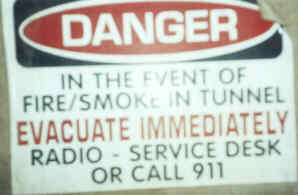We've been tossing this stuff around for a while.
Since few of our vertical mine situations are exactly the same, I think the best answer is that there isn't a single answer that works best.
You'd want to figure out which systems work best for you and the folks you explore with.
One to bring a person up while you're tending them from the side, one to bring them up while they're below you (tighter shaft) and you're controlling the rigging.
One for you to raise them from the top/bottom, perhaps.
| What if you're the one climbing on the rope and you swing out suddenly and slam into the wall or something heavy falls down and hits you on the head or whatever, knocking you out cold. You need to be either pulled up to safety very quickly, or brought down quickly (while a rapid haul system can be rigged up) before you hang there for too long. |
When I was doing extremely hazardous dismantle jobs in tree work, I would rig my "swing away" backup system. It doubled as my safety descent in-case I was knocked unconscious or severely injured.
I would basically be tethered to a separate life-line, which is rigged over a pulley and down to an anchor. But I wasn't just anchored off; a lowering device (figure 8/atc/rack/etc) was rigged to the anchor down below, and my line went down through that, rigged backwards, with enough spare rope on the ground so that if I were in trouble, a ground crew member could run over and untie the safety knot and then lower me to the ground.
A similar system can easily be set up when you're rappelling shafts.
Here's a question for you though....
You should seriously consider that, given the injury, at what point do you decide you DON'T have the equipment/expertise, and you call in professional help?
You should think about this stuff ahead of time, so you don't waste time trying to do the 'save' if someone is nearly-critically injured.
And unless you've got a backboard/basket and all the means to properly C-spine someone while keeping their head/neck stable WHILE they're being raised... (and enough people on hand to make it possible), then you should leave that kind of thing to the people who train doing that on a regular basis and are prepared to safely make that kind of extraction.
Maybe a broken hand/wrist/ankle/leg/foot; that you'd try to get them out yourself?
What if your buddy breaks their leg, and decide they'd prefer a professional rescue vs. one that's thrown together with fellow adventurers who have minimal training?
What if YOU break your leg, and your fellow explorers don't have the training/expertise/confidence that you have?
Just food for thought.
There are some active and passive powered solutions to your problem as well, but they will cost you from $2000 to $4000.
One is a system I'm a qualified person on, by Tractel.
http://www.tractel....php?id_master=122 I've used the "Derope Up A" and the "Derope Up E"
They're *meant* for lowering a person, but those sytems are also rigged to allow you to winch someone up; so they do both.
You can even take an "uncontrolled descent" on one, like we would at work, if we had to escape a burning wind turbine as the last-man-out. You clip in and just...go.... it controls your downward speed (3'/sec).
We have to carry one every single time we climb a wind turbine tower, as our self-rescue device.
The winch part is nice, because if someone has fallen and are hanging from their fall arrest lanyard, you can pick them "up" with it just enough to unclip them, then lower them down.
The other device is the PowerQuick PQ500-1
http://powerquickinc.com/pq500-1.htm A battery-powered portable capstan device which allows you to pull loads up to you, or clipped to you will pull you up to your anchor.
You can read the specs yourself. It's a pretty impressive device.
Last year I had emailed the folks who own that company, and who designed that device. Very nice people, a husband and wife. We were discussing the use of that device in mines not only for rescue applications, but also for ascending back up out of verticals using it as a power-assist, without having to frog.
It will also passively descend a line.
I had gotten a price list from them, but I don't know where I put it.
Lots of options out there. I'm tempted to save my shekels and purchase the powered device next time I'm able to. The possibilities it could open up for me would be almost endless.


 order your copy of Access All Areas today!
order your copy of Access All Areas today!













